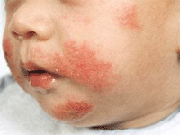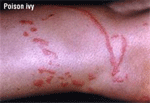

Do you often suffer from red, bumpy, scaly, itchy, inflamed/blistered or swollen skin? Dry skin, sunburn or an insect bite may be the cause. Or, you may have a skin allergy. The most common skin allergies include eczema, hives/angioedema and contact dermatitis.


Urticaria is another term for "hives." The condition affects an estimated 20 percent of the population at one time or another in their lives. An episode of hives can start as itching, followed by swollen, red welts. The itching may be mild or severe. Scratching, alcoholic beverages, exercise, and emotional stress may worsen the itching
Angioedema appears on the eyelids, lips, tongue, hands and feet and is typically not red or itchy—just swollen. The allergens that trigger hives may take days to leave the body, so an allergist/immunologist may prescribe antihistamines or in severe cases, steroids. Other tips for symptom relief are cool showers, applying a cool compress or wearing loose/light clothing.
When certain substances come into contact with your skin, they may cause a rash called contact dermatitis. Irritant contact dermatitis is often more painful than itchy, and is caused by a substance damaging the part of your skin it comes into contact with. The longer your skin is in contact with the substance, or the stronger the substance is, the more severe your reaction will be. These reactions appear most often on the hands and are frequently work-related.


Poison ivy, poison oak, and poison sumac are common plants of the genus toxicodendronthat contain an oil called urushiol. When urushiol oil touches the skin, many people develop an itchy and inflamed rash due to an immune response called contact dermatitis.
Both poison ivy and poison oak grow clusters of three leaves, which has lead to the saying "leaves of three, let it be!" to help remember how to identify the plant.
